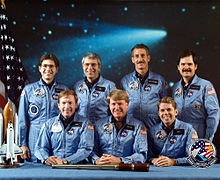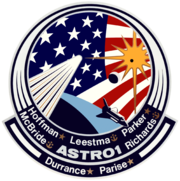STS-61-E
| Mission duration | 8 days, 22 hours, 2 minutes |
|---|---|
| Spacecraft properties | |
| Spacecraft | Space Shuttle Columbia |
| Crew | |
| Crew size | 7 |
| Members |
Jon McBride Richard N. Richards Jeffrey A. Hoffman David Leestma Robert A. Parker Samuel T. Durrance Ronald A. Parise |
| Start of mission | |
| Launch date | 6 March 1986, 10:45 UTC |
| Launch site | Kennedy LC-39B |
| End of mission | |
| Landing date | 15 March 1986, 08:47 UTC |
| Landing site | Kennedy Runway 15 |
| Orbital parameters | |
| Inclination | 28.5 degrees |
 Back row, L-R: Durrance, Parker, Hoffman, Parise. Front row, L-R: Richards, McBride, Leestma |
|
STS-61-E was a United States Space Shuttle mission planned to launch on March 6, 1986 using Columbia. It was cancelled after the Challenger disaster.
Columbia was to carry the ASTRO-1 observatory, which would be used to make astronomical observations including observations of Comet Halley. ASTRO-1 consisted of three ultraviolet telescopes mounted on two Spacelab pallets, controlled by the Instrument Pointing System which was first tested on STS-51-F.
After the Challenger disaster, the flight was remanifested as STS-35 and several crew members were replaced. Both Richards and Leestma were reassigned to STS-28 while McBride left NASA in 1989. Vance Brand replaced McBride as the commander while Guy Gardner and Mike Lounge replaced Richards and Leestma, respectively.
...
Wikipedia

